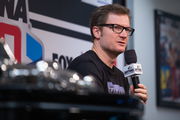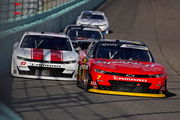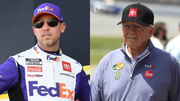

Under the lights on Saturday, Bristol witnessed 46 fewer lead changes than the Spring Race threw at the beginning of the season. However, for reasons unknown, it turned out to be the fastest a Cup Series field has ever run in Thunder Valley since the race track’s opening in 1961. Averaging speeds of 101.277 MPH, this year’s Night Race was 20 miles-per-hour quicker than the 2024 Food City 500.
Despite all that, a majority of the fans in the grandstands felt that the 2024 Bass Pro Shops Night Race didn’t quite hit the mark in their eyes. Was it the lack of passing? Was it Kyle Larson’s domination? Or maybe the almost non-existent lap-time fall-off on Goodyear’s Eagles did not match the audience’s expectations after everything that went down on its surface back in March? Well, the controversial spotter cast of Door Bumper Clear has stepped up with some stern answers for those blaming NASCAR’s official tire partners in this mystery.
ADVERTISEMENT
Article continues below this ad
NASCAR spotters break down Bristol’s tire “debate”
The Bristol Spring Race has etched its spot into the NASCAR history books as one of the most mysterious races in recent regard. Switching from the traction-enhancing ‘PJ1 Trackbite’ to a resin compound before the March event, cars experienced unnatural tire fall-off on race day. Tire codes, D-5170 (rights), and D-5206 (lefts) started going down after 30-40 lap runs on the warmer Bristol concrete. At the end of 500 laps, most realized that what we had just witnessed might have been a once-in-a-lifetime moment.
Denny Hamlin and his #11 team played the game best in March to emerge victorious for the second-straight time on Bristol’s surface. But when Goodyear brought the same tire codes for the night race, he finished 4th. During practice, many observed that the tire wear differed quite a bit from what we had witnessed in March. Even race-winner Kyle Larson had informed Bob Pockrass that he developed an awareness of these altered situations by “Lap 10 in practice.” Maybe that helped him lead almost 92% of all laps on Saturday. However, trailing Larson’s run by over ten seconds, Hamlin had some glaring grievances after the race.
“It (the tires) either doesn’t last 40 laps or it lasts 200,” opined the #11 driver. “We’ve got to get some consistency in the tires going but other than that, all these cars are equal, the drivers are equal and that’s why it’s so hard to pass.” And it wasn’t just him. Many joined in the debate. Some pointed their fingers at NASCAR, some at SMI (owners of the Bristol Motor Speedway), and even more blamed Goodyear for being unable to come up with a more ‘exciting’ tire. But when a fan asked the spotters on Door Bumper Clear if we ‘should expect the tire debate to carry over to the next season,’ Brett Griffin dismissed the question rhetorically, stating, “What’s the debate? Who are they debating against? Who are they debating with?….”
Explaining himself better, the former Cup spotter, said, “Goodyear has a monopoly on what they bring. I mean they own the tire rights. And we race what they bring. So I don’t know who they would debate against. I’m sure they can take input from teams, NASCAR, maybe TV.” His co-host TJ Majors continued where Griffin left off to clarify, “But now that you’ve got the same track twice this season. And you’ve got totally different outcomes with the same tire. I think, now you can dissect it more and probably go in and collect a lot of data. And see what you can do differently.”

USA Today via Reuters
Sep 17, 2022; Bristol, Tennessee, USA; NASCAR Cup Series driver Christopher Bell (20) and driver Kyle Larson (5) and driver William Byron (24) and driver Brad Keselowski (6) during the Bass Pro Shops Night Race at Bristol Motor Speedway. Mandatory Credit: Randy Sartin-USA TODAY Sports
In fairness, it was nigh impossible for NASCAR and Goodyear to predict how the tires, or the surface, would react to the various changes this time around in Bristol. However, when the officials realized something was wrong with how the racetrack reacted to the racing after the 45-minute practice session, they applied “approximately two feet of PJ1 to the bottom of the racing surface and cleaned the top groove of excess rubber.” The drivers initially preferred this compound instead of the resin used in March, as most believed that the PJ1 would increase tire-cording as the night progressed on a cooler surface.
What’s your perspective on:
Is Goodyear really the best choice for Bristol, or are we just ignoring the real issues?
Have an interesting take?
Alas, that wouldn’t be the case. The lower groove seemed the fastest, with most attempting passes on the inside lane. Adding to that, the only driver affected by tire issues was Ty Gibbs, who saw his championship hopes slip away after overcoming a speeding penalty and then overheating his radials late in the race. It is quite clear by now that something much bigger than the tires keeps impacting the sorrowful state of modern-day short-track racing on iconic tracks like Bristol.
Hence, from Denny Hamlin to rival crew chiefs to team owners like Richard Childress, and Griffin’s pod partner TJ Majors, the experts had their nuanced opinions on what could be the probable villain in this story.
Trending
The rubber hit the road… and no one knows why
In the words of Dale Jr’s spotter, who answered a separate question on Ask DBC, “I think you go there expecting to wear the right fronts, if you are going back with the same tire. I definitely think it was a huge factor. And I think people probably took a lot of camber and stuff out to try and save the wear on the right front and it hurt. So I do think that probably played a big factor in it.”
Besides, it wasn’t exactly an uninformed decision from NASCAR and Goodyear to bring the Spring Race ‘Eagles’ to Bristol for the Bass Pro Shops Night Race. Amid a sweltering July, six Cup drivers tested tires on a warm Bristol surface to determine the optimum setups for September 21st. One of those six drivers, Chase Briscoe, seemed a little skeptical back then, deducted that “there wasn’t much rubber laid down with only six cars here.”
ADVERTISEMENT
Article continues below this ad
After another mysterious run at Bristol this past Saturday, his crew chief Drew Blickensderfer held a newer perspective, and told the media, “The tire tests they did here with 14 car, it was just like March, you know… We could go 120 laps with no issues. Not sure what is completely different, but it’s not what … everybody expected.” Statements like that only add fuel to the fire from team owners such as Richard Childress, who had recently revealed: “I don’t know if they changed the tiniest little thing in the tire and didn’t tell us but that’s sometimes how it works.”

USA Today via Reuters
Sep 19, 2020; Bristol, Tennessee, USA; General view of pit row during the Nascar Bass Pro Shops NRA Night Race at Bristol Motor Speedway. Mandatory Credit: Randy Sartin-USA TODAY Sports
Although Goodyear does not release the official materials and ratios used in these 18′ tires, Ricky Stenhouse Jr’s crew chief, Mike Kelley, had a careful explanation. “That spring race is going to go down as one of the great asterisks,” declared the man. He elaborates, “It’s such an oddity. They tell us the tires are the same and I guess, if they tell me that enough, I’ll start to believe them. I’m not saying I don’t but there just had to be something different that night.”
ADVERTISEMENT
Article continues below this ad
In a scathing address, Kelley made many things clearer. “They tested it in cold weather and got the same thing. They tested it in hot weather and got the same thing… Wore tires out big time in the summer test. We live in this databased world and we all spend a lot of money on really smart people and so many of them have no idea how to explain what happened that night.”
Indeed, it appears the 2024 Bristol Spring Race mystery is destined to remain just that, for now—a mystery. But NSACAR must solve their short-track woes for good with this Gen 7 car. After all, the aerodynamic issues were visibly evident in the lack of passing over the weekend. With that being said, what do you think is causing the racing product to deteriorate by the day on tracks under a mile in length? Let us know in the comments below.
Have something to say?
Let the world know your perspective.
ADVERTISEMENT
ADVERTISEMENT
ADVERTISEMENT
ADVERTISEMENT






Is Goodyear really the best choice for Bristol, or are we just ignoring the real issues?